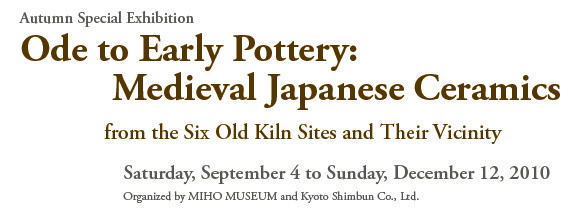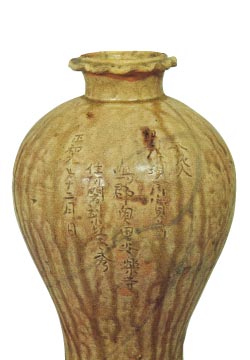
Featured here are pots and jars necessary for
storing the five grains (wheat, rice, beans, millet, and foxtail millet)
and water in medieval Japan. The strength and simplicity that can be
seen in their forms are one of the great allure of medieval Japanese
pottery. The cherished ceramics of the six old kiln sites have captured
the hearts of many. They include the hearty and rustic Tokoname and
Echizen wares, the bright and robust Shigaraki, the simple and elegant
Tanba with its dripping glaze, the bold and majestic Bizen, and the sole
glazed ware, the graceful yet powerful Seto.
Ode to Early Pottery explores these medieval Japanese ceramics and presents an overview through approximately 170 ceramic pieces. Exemplary works from the six kilns will be highlighted together with examples from other nearby kiln sites. The result of scholarly research on the history of medieval kiln sites, this major ceramic exhibition, the first of its kind in thirty years, will begin at MIHO MUSEUM and thereafter travel to four venues throughout Japan.
Ode to Early Pottery explores these medieval Japanese ceramics and presents an overview through approximately 170 ceramic pieces. Exemplary works from the six kilns will be highlighted together with examples from other nearby kiln sites. The result of scholarly research on the history of medieval kiln sites, this major ceramic exhibition, the first of its kind in thirty years, will begin at MIHO MUSEUM and thereafter travel to four venues throughout Japan.
 |
|||||
In the early Kamakura period, from the late 12th to 13th
century, Seto inherited the techniques of the Sanage kilns and
began by producing high-fired glazed ceramics. Like the Sanage
kilns, this site originally imitated Chinese celadon and white
porcelain and produced luxury ware in the taste of
Kamakura-period warriors, courtiers, and priests of temples and
shrines. The products of the Seto kilns were so central to its
age that ceramics in general came to be called “Seto ware.” This
may have been because Seto ware was the only glazed high-end
ware in a period when the other kilns only produced unglazed
ceramics. Blessed with excellent clay, Seto was able to meet the
demands of those who admired luxurious Chinese ceramics. Elegant
yet bold, Seto ware perhaps reflects the unaffected and sincere
temperament of the rustic warrior class.
|
 |
||||
|
 |
||||
|
|
|
|
|
||